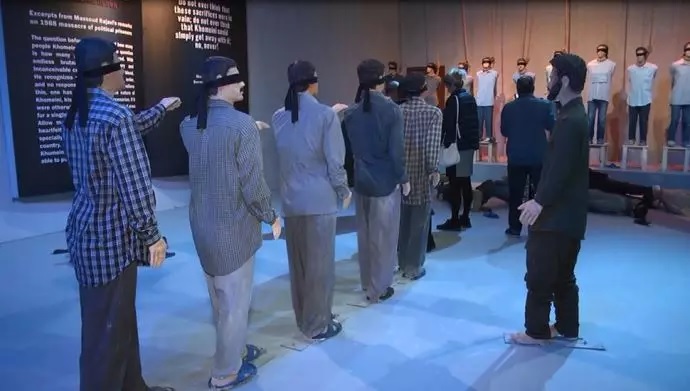
In August 1988, in one of the cells of Ahvaz prison, two executioners named Jazayeri and Abdollahi shouted: “You have to take a stand, one choice is Khomeini and the other is Masoud Rajavi. Which side do you stand on?”
From the end of the band, a girl shouted: “Hail to Massoud, death to Khomeini!”
Her name was Sakine Delphi, a 26-year-old supporter of the People’s Mojahedin Organization of Iran (PMOI/MEK) from Abadan.
The guards attacked and tortured her. The next day she was executed along with other prisoners because she did not denounce her support for the MEK.
She was one of more than 30,000 political prisoners who were executed because they stood their ground against the mullahs’ regime. Many of them had finished their prison terms and should have been released even by the regime’s own laws.
Organized crime of Khomeini’s mercenaries
The beginning of August every year marks the anniversary of the 1988 massacre of 30,000 political prisoners by Ruhollah Khomeini, a crime against humanity that has been described as the most brutal massacre of prisoners since World War II. The extent of this massacre is astonishing. It was implemented in at least 110 cities in the country. More than 90 percent of the massacred prisoners were supporters of the PMOI/MEK. Political prisoners affiliated with other groups were also executed.
Khomeini had wanted for years to annihilate every last member and supporter of the MEK. After being forced to accept the cease-fire resolution in the anti-patriotic war with Iraq, he gave the final order to purge prisons of all people associated with the main opposition movement.
Those who carried out the executions hold positions of power today, including current regime president Ebrahim Raisi, who at the time was a member of the “Death Commission,” a group of so-called judges who handed out the death sentence of the victims in minutes-long trials.
Geoffrey Robertson’s testimony
Geoffrey Robertson, QC, Human Rights Barrister and first President of the UN Special Court for Sierra Leone, has investigated the 1988 massacre. He recounts this horrific event as such:
“Late in July 1988 as the war with Iraq was ending, prisons in Iran that were crammed with opponents suddenly went into lockdown. All family visits were canceled television and radios switched off. Prisoners were kept in their cells not allowed exercise or trips to the hospitals. The only permitted visitation was from a delegation, turbaned and bearded, which came in black government BMW’s a religious judge, a public prosecutor, and an intelligence chief. Before them were paraded briefly and individually, almost every prisoner, and then thousands of them who were being jailed for adherence to the MEK.
“The delegation and but one question for these young men and women, most of them detained since 1981, merely for taking part in street protests or possession of political reading material, and although they didn’t know it, on their answer their life would depend. Those who by their answer by evidence any continuing affiliation with the MEK were blindfolded and ordered to join a conga line that led straight to the gallows. They were hung from cranes four at a time, or in groups of six, from ropes hanging from the front of the stage of the assembly hall, some were taken to army barracks at night, directed to make their wills, and then shot by firing squad. Their bodies were doused with disinfectant, packed in refrigerator trucks and buried at night in mass graves.
“Months later their families, desperate for information about their children, would be handed a plastic bag with their few possessions they would be refused any information about the location of the graves, and ordered never to mourn them in public. By mid-august 1988 thousands of prisoners had been killed in this manner by the state. Without trial, without appeal and utterly without mercy.”
Time has come to hold the leaders of the Iranian regime to account
The time has come for the international community to end nearly four decades of impunity for the leaders of the religious fascism ruling Iran and hold them accountable for their crimes.
The time has come to refer the case of human rights violations in Iran, especially the executions of the 1980s and the massacre of 1988, to the United Nations Security Council.
The time has come for regime supreme leader Ali Khamenei, regime president Ebrahim Raisi and their accomplices to face justice for committing crimes against humanity. How can the world sit at the United Nations with those who were directly involved in the massacre of tens of thousands of prisoners?
At a recent conference on the 1988 massacre held at the headquarters of the National Council of Resistance of Iran (NCRI) in Paris, Prof. Melanie O’Brien, President of the International Association of Genocide Scholars, stressed that with Ebrahim Raisi being the regime’s president, there can be no expectation of justice for the victims from inside Iran.
“The international community thus needs to unequivocally support accountability processes to ensure justice for the victims and their families who have not been permitted to properly mourn their loved ones. What form those processes take, however, is the biggest challenge,” she said.
Professor O’Brien referred to the recent case of Hamid Noury, a former guard in Gohardasht prison who was tried in Sweden for his role in the 1988 massacre, as an example to follow. “Sweden’s example should be followed by other countries,” she said. “This would effectively render a travel ban on those who participated in the 1988 executions and those who are perpetrating current crimes, as they would be arrested if they traveled abroad. Therefore, this would complement any current sanctions regimes against Iranian individuals.”
This post was originally published on this site be sure to check out more of their content.






